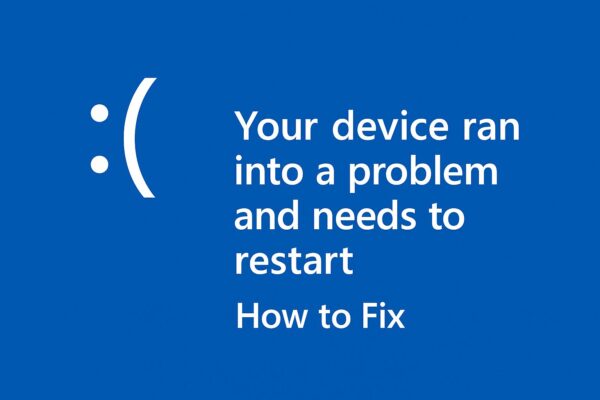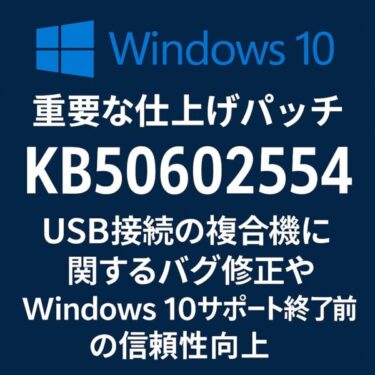
- 1 What to Do When You See “Your Device Ran Into a Problem and Needs to Restart” on Windows
- 2 What Is the “Your Device Ran Into a Problem” Error?
- 3 Main Causes of the Blue Screen Error
- 4 First Steps When You See the Error
- 5 What to Do If It Keeps Happening
- 6 Advanced Tips for Persistent Errors
- 7 July 2025 Update: New Devices, New Problems
- 8 Final Thoughts
What to Do When You See “Your Device Ran Into a Problem and Needs to Restart” on Windows
Have you ever been using your PC—whether browsing the web, editing documents, or simply checking your email—when suddenly the screen turns blue with a message like:
“Your device ran into a problem and needs to restart.”
If so, you’re not alone. This message is part of what’s known as a Blue Screen of Death (BSoD), and it’s one of the most alarming things that can appear on a Windows device.
But don’t panic—this guide will walk you through:
- Why this error happens
- What to do when you see it
- How to prevent it from happening again
What Is the “Your Device Ran Into a Problem” Error?
This message means that Windows has detected a serious system error and must restart your PC to prevent damage or data loss. It usually looks like this:
- Blue screen with white text
- A stop code (e.g.,
MEMORY_MANAGEMENT,CRITICAL_PROCESS_DIED) - Sometimes a QR code linking to Microsoft’s help page
These errors are called “stop errors” or “blue screen errors” and are usually caused by one of the following:
Main Causes of the Blue Screen Error
1. Faulty or Outdated Drivers
Drivers are software that allows your hardware (such as printers or graphics cards) to communicate with Windows. If they’re outdated or corrupted, they can trigger blue screens.
2. Corrupted System Files
Interruptions during Windows updates, sudden power-offs, or disk errors can corrupt essential Windows files.
3. Hardware Failure (Memory or Hard Drive)
On older PCs, physical degradation of memory (RAM) or hard drives is a common cause. You may notice unusual noises or sluggish behavior before a crash.
4. Malware or Virus Infection
Malicious software can disrupt system operations, damage files, or conflict with security components.
5. Software Conflicts
Recently installed apps or drivers that are incompatible with your system can result in a blue screen error.
First Steps When You See the Error
1. Let It Restart
In most cases, Windows will restart automatically. Don’t interrupt the process. If it boots up normally afterward, it might have been a one-time error.
2. Note Down the Stop Code
Pay attention to the stop code displayed on the blue screen. It may look like:
CRITICAL_PROCESS_DIED
If you can’t write it down in time, try snapping a photo with your phone—it can disappear quickly.
3. Recall Recent Changes
Did you install a new app or update Windows shortly before the error? If so, that change may be the cause. Make a list of any recent changes for troubleshooting later.
What to Do If It Keeps Happening
If the blue screen happens more than once, or every time you start your PC, take these steps:
1. Use System Restore
Go back to a previous working state using System Restore. This will revert your system files and settings to an earlier time without affecting personal files.
2. Update or Reinstall Drivers
Open Device Manager (devmgmt.msc), right-click any problem devices, and select “Update driver” or “Uninstall device” and reinstall.
3. Check for Windows Updates
Go to Settings → Windows Update and install any available updates. New updates may fix known issues or improve compatibility.
4. Run Hardware Diagnostics
Use built-in tools like Windows Memory Diagnostic (search “mdsched”) or third-party tools like CrystalDiskInfo for hard drives.
Advanced Tips for Persistent Errors
Analyze the Stop Code
Stop codes like MEMORY_MANAGEMENT or KERNEL_SECURITY_CHECK_FAILURE indicate specific areas of failure. Search Microsoft’s site or tech forums for solutions based on that code.
🔧 Boot into Safe Mode or Automatic Repair
If your system won’t start normally, force shut down the PC 2–3 times while it’s booting to trigger Automatic Repair. From there, go to “Advanced Options” → “Startup Repair” or “Safe Mode.”
Perform a Clean Boot
Disable all non-Microsoft startup items and services via msconfig to rule out conflicting apps. This helps narrow down the culprit if the error is software-related.
Beware of Known Issues in Windows Updates
Check Microsoft’s official update history for known issues related to your current build. Some updates may be causing crashes and require rollback or patches.
July 2025 Update: New Devices, New Problems
- USB devices not recognized (Error Code 10): Still common in Windows 11 24H2. Try reinstalling drivers manually.
- Bluetooth randomly disconnects: Change power management settings in Device Manager to prevent automatic shutdown of Bluetooth hardware.
- Missing devices after Windows Update: Use
PnPUtilin PowerShell to rescan and reinstall missing drivers.
Still No Luck? Here’s What to Try Next
- Boot into Safe Mode and investigate
- Contact PC manufacturer or repair technician
- Consider resetting your PC (Settings → Recovery → Reset this PC)
Warning: A factory reset will erase your files unless you choose “Keep my files.”
Final Thoughts
Seeing the message “Your device ran into a problem and needs to restart” can be scary, but in many cases, it’s fixable with some simple steps.
If it happens only once, don’t worry too much. But if it keeps coming back, take action—check for hardware issues, run diagnostics, update your drivers, or reach out for professional help.
Always back up your important data regularly to avoid losing files in case of critical system errors.
Related Article: “Windows can’t start because a file is missing or corrupt” — Still hope?
✔️You might also find these helpful:
▶︎Realtek Audio Device Not Showing on Windows 11? Here’s How to Fix It (2025 Edition)
▶︎Windows Help Made Easy: A Troubleshooting Guide for Seniors & Beginners
💡 Looking for more tips? Check out our full list of Windows Help Guides.


